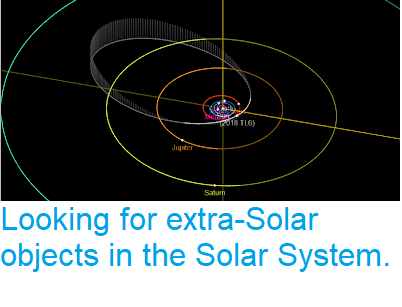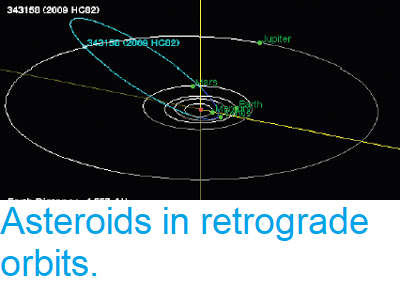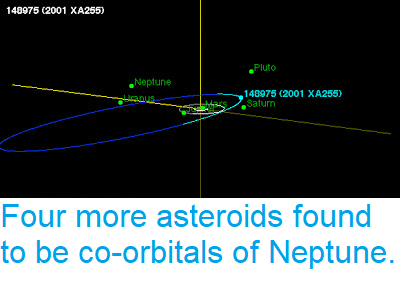The Jupiter Trojans are small solar system bodies that share Jupiter’s orbit around the Sun and reside in one of two 'clouds' associated with the stable L4 and L5 Lagrange regions located 60 ahead of and behind the planet in its orbit. Their origins are currently uncertain, with potential scenarios under debate including formation near their current locations and capture by Jupiter from source regions farther out in the Solar System. Observational studies have shown the population to consist primarily of C-, P-, and D-type asteroids, where measurements of low densities for some objects indicate that they could be highly porous, volatile-rich, or both. Thermal models have shown that water ice could remain preserved on Jupiter Trojans over the age of the solar system under just 10 cm of dust at their poles to 10 m of regolith elsewhere. Thus, cometary activity could be possible on Trojans, perhaps triggered by impacts and driven by hypervolatile species like carbon monoxide or carbon dioxide. No active Trojans have been reported to date, however.
Animation showing the motion of the Jupiter Trojan Asteroids. Petr Scheirich/Astronomical Institute of the Czech Academy of Sciences/NASA.
P/2019 LD2 was discovered on 10 June 2019 at a heliocentric distance of 4.666 AU (4.666 times the average distance at which the Earth orbits the Sun) by the 0.5-m Asteroid Terrestrial-Impact Last Alert System telescope on Mauna Loa in Hawaii. Suspected cometary activity in discovery images analysed by the ATLAS team was confirmed by follow-up observations on 11, 13, and 29 June 2019. The object currently has Jupiter Trojan-like orbital elements, with a semimajor axis (average distance from the Sun) of 5.3279 AU, an eccentricity of 0.1407, and inclination relative to the plain of the Solar System of 11.517. If P/2019 LD2 is in fact a Jupiter Trojan, it would represent a unique opportunity to study the volatile content and behavior of a member of this population of objects for the first time and to use the results of those investigations to constrain models of solar system formation.
The calculated orbit and current position of P/2019 LD2 (ATLAS). JPL Small Body Database.
However, a heliocentric ecliptic latitude and longitude plot of P/2019 LD2 and other Jupiter Trojans at the time of the object’s discovery gives an indication that P/2019 LD2 might not be a true Jupiter Trojan, as it much closer to Jupiter in ecliptic longitude (roughly 10°) than any other Jupiter Trojans (roughly 40-100°) and does not clearly belong to either the L4 or L5 clouds. Dynamical analyses suggest that P/2019 LD2’s orbital elements are unstable, inconsistent with the behavior expected of a true Jupiter Trojan, while similar analyses disputing P/2019 LD2’s classification as a Jupiter Trojan were reported by amateur astronomers Sam Deen and Tony Dunn in posts to the Minor Planet Mailing List.
In a paper published on the arXiv database at Cornell University on 28 July 2020, and submitted to the journal Icarus, Henry Hsieh of the Planetary Science Institute and the Institute of Astronomy and Astrophysics at Academia Sinica, Alan Fitzsimmons of the Astrophysics Research Centre at Queens University Belfast, Bojan Novaković of the Department of Astronomy at the University of Belgrade, and Larry Denneau and Aren Heinze of the Institute for Astronomy at the University of Hawaii, present numerical integration results confirming and characterizing the non-Trojan-like dynamical behavior of P/2019 LD2 and briefly discuss the implications of this object for current and future surveys.
To assess P/2019 LD2’s dynamical nature, Hsieh et al. generated 100 dynamical clones drawn from the multivariate normal distribution for the object (as of i June 2020), defined by an orbital covariance matrix, provided by the JPL Small Bodies Database. Dynamical clones werer used to assess the amount of potential divergence due to chaos in P/2019 LD2’s predicted orbital evolution that could occur due to the object’s orbital element uncertainties. Hsieh et al. also performed the same procedure for six reference Jupiter Trojans: (588) Achilles, (624) Hektor, and (659) Nestor from Jupiter’s L4 Trojan cloud and (617) Patroclus, (884) Priamus, and (1172) Aneas from the L5 cloud. They then conducted backward and forward numerical integrations for all objects and their clones for 1000 years in each direction, using the Bulirsch-Stöer integrator in the Mercury N-body integration package. To study the long-term stability of P/2019 LD2, Hsieh et al. conducted forward integrations for 1 million years for all test particles. All integrations accounted for gravitational perturbations from the seven major planets except for Mercury and used an initial time step of 0.1 days. In all integrations, particles are removed when they reach over 100 AU from the Sun. Non-gravitational forces were not included.
An image of P/2019 LD2 (ATLAS) taken from the Las Cumbres Observatory at Cerro Tololo in Chile on 11 June 2019. James Armstrong/Institute for Astronomy/Las Cumbres Observatory/Space.com.
Hsieh et al. confirm that P/2019 LD2 is only temporarily in a Jupiter Trojan-like orbit, while they find its overall dynamical behavior to be that of an active Centaur transitioning into a Jupiter-family comet. Hsieh et al. found that P/2019 LD2’s semimajor axis became Jupiter Trojan-like (with a semi-major axis of between 5.0 and 5.4 AU) in July 2018 and will remain in that range until February 2028. The transitions into and out of P/2019 LD2’s current orbit correspond to close encounters with Jupiter for all P/2019 LD2-associated test particles (i.e., the object itself as well as all of its dynamical clones) Hsieh et al.'s integrations when the object passed within 0.09 AU (or 0.25 of the Jupiter Hill radius, where 0.355 AU is Jupiter’s Hill radius; the radius within which an object can potentially become a satellite of Jupiter) from Jupiter on 20 February 2017, and will pass within 0.12 AU (0.34 Jupiter Hill radius) from Jupiter on 12 May 2028.
Immediately prior to reaching its current Jupiter Trojan-like orbit in July 2018, P/2019 LD2’s orbital elements. An object is considered a Centaur if both its perihelion (the closest point on its orbit to the Sun) and its semi-major axis (average distance from the Sun) fall between the orbit's of Jupiter and Neptune, and it is not in a 1:1 mean-motion resonance with any planet. P/2019 LD2 is expected to return to a Centaur-like orbit in February 2028 and remain there until February 2063, when a very close encounter with Jupiter at 0.03 AU (0.08 of the Jupiter Hill radius) in January 2063 will lower both its semimajor axis and perihelion distance to well inside the orbit of Jupiter, at which point, the object will be considered a Jupiter Family Comet. For comparison, integrations of our reference Trojans indicate that they remain on stable orbits for the duration of both our backward and forward 1000-year integrations. While the eccentricities of some of these objects drift smoothly over time and their semi-major axis and perihelion exhibit small oscillations, Hsieh et al. see none of the sharp orbital element changes exhibited by P/2019 LD2.
Hsieh et al. found that the orbital evolution trajectories of P/2019 LD2 and all of its dynamical clones in our integrations between 1851 and 2063 are nearly identical, suggesting that their results likely reliably capture P/2019 LD2’s true orbital evolution during this period. However, before and after this time period, which is bracketed by close encounters with Jupiter at distances of 0.5 AU (1.4 of the Jupiter Hill radius) in November 1850 and 0.03 au (0.08 of the Jupiter Hill radius) in January 2063, trajectories from Hsieh et al.'s integrations for P/2019 LD2 and its dynamical clones diverge widely. This divergence is a result of the chaotic nature of P/2019 LD2’s orbit, especially during close encounters with Jupiter, and indicates that predictions about the object’s dynamical behavior before 1851 or after 2063 should be regarded as highly uncertain. Consideration of non-gravitational perturbations due to cometary outgassing could introduce even more uncertainty to our analysis of P/2019 LD2’s orbital evolution, but given the expected weakness of any cometary activity at these large heliocentric distances, Hsieh et al. expect outgassing perturbations to be essentially negligible compared to e
ffects from the close encounters with Jupiter.
In Hsieh et al.'s 1 million year forward integrations of its nominal orbit, the semi-major axis of P/2019 LD2 passes 100 AU (and is removed from the integrations) in 990 000 years (with many significant orbital element changes during that time), while the semi-major axis all but three of its dynamical clones also pass 100 AU within 1 million years with a median lifetime of 110 000 years. This dynamical evolutionary behavior is consistent with current short-period comets, and contrasts sharply with our six reference Trojans, all of which remain in e
ffectively the same orbits for the full 1 million year integrations, further highlighting the dynamical distinction between P/2019 LD2 and true Jupiter Trojans.
Despite the findings described above, it is possible that P/2019 LD2 could have been a true Jupiter Trojan in the past and was driven onto its current orbit by non-gravitational perturbations arising from its cometary activity or other e
ects. Jupiter Trojans are expected to occasionally escape from their stable orbits due to chaotic di
usion or collisions, and potentially contribute to other populations such as Centaurs and Jupiter Family Comets, and cometary non-gravitational perturbations could certainly accomplish similar e
ffects. Given the object’s clearly un-Trojan-like recent orbital history, however, we consider this to be an implausible scenario. There is no reason that P/2019 LD2’s current transient resemblance to Jupiter Trojans should suggest that it is necessarily more likely than any other Centaur to have been a Jupiter Trojan in the past. Nonetheless, a future analysis of escape trajectories from the Trojan clouds involving non-gravitational perturbations due to cometary outgassing could be useful for assessing the potential contribution of active Jupiter Trojans to the Centaur and Jupiter Family Comets populations. In the meantime, observational characterisation of P/2019 LD2’s surface to determine if it has the ultrared colours of other Centaurs or has C-, P-, or D-type colours similar to other Jupiter Trojans would be very useful for confirming the object’s true origin.
While P/2019 LD2 is not a true Jupiter Trojan, its discovery is nonetheless instructive. Current surveys like ATLAS will continue to discover active objects, some of which may belong to populations not previously known to exhibit activity, and upcoming surveys like the Vera C. Rubin Observatory’s Legacy Survey of Space and Time promise to discover even more. The temporary capture of objects onto Trojan-like orbits is not expected to be frequent, but also not exceedingly rare, where Hsieh et al. note that temporary satellite captures could also be found to have nominally Trojan-like orbital elements. As such, more cases like P/2019 LD2 should be expected in the future.
Computationally scalable approaches for accurately dynamically classifying objects of interest discovered by wide-field surveys in a timely manner will be needed for both largescale population studies and investigations of individual targets, especially as discovery rates increase. To identify true Jupiter Trojans, possible approaches include using Lyapunov Characteristic Exponent values or proper orbital elements to ensure that a given object is in a stable 1:1 mean-motion resonance with Jupiter. Both proper orbital elements and Lyapunov Characteristic Exponent values are currently provided by the AstDyS-2 website for all numbered and multi-opposition Jupiter Trojans, and preparations are being made to continue doing so in the Legacy Survey of Space and Time era, although their computation typically requires relatively high-quality orbits. For newly discovered objects of high interest that have lower-quality orbits, it may be useful to develop mechanisms for performing more rapid preliminary dynamical analyses using N-body integrations as was done in this work (perhaps also allowing for cometary non-gravitational perturbations).
While recent sharp decreases in P/2019 LD2’s semimajor axis and perihelion distance are perhaps the most plausible trigger of its current activity, tidal disruption or resurfacing from the object’s close encounter with Jupiter in 2017 could also have contributed to making cometary activity more likely by disrupting surface material and excavating buried surface ice. In this regard, systematic N-body integration analyses could also be useful for identifying small bodies that have experienced recent close planetary encounters so that they can be monitored for possible cometary activity.
See also...
Follow Sciency Thoughts on Facebook.









